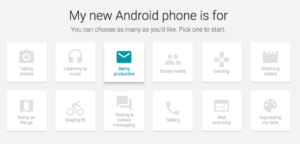How to Reduce Cart Abandonment

Running a successful eCommerce store is anything but easy.
You’ve got to ensure your site is optimized for increased conversions, constantly amend recorded stock levels, run seasonal and one-off promotions, deal with customer service, etc etc..
The list goes on and on. Running an eCommerce store ain’t easy!
It takes a lot of time and money to run one effectively. And when you’re pouring so much of your time, attention, and money into a business…
Every. Penny. Counts.
But there’s a huge problem in eCommerce. One which is far more damaging than running low on stock or sending a promotional email a day late.
I am of course talking about cart abandonment.
We’ve all seen the stats and rates for cart abandonment, but what most don’t know is the stats most often quoted are wrong.
When you read an article on CA you’ll see that most people quote the aggregate study from the Baymard institute. But that study doesn’t tell the whole story. The Baymard study average is built on outdated statistics. Seriously, if you go have a look now you’ll see stats from 2012.
No one cares how people reacted in 2012. We care how many people are abandoning their carts in 2017. Many of those statistics are from 5-6 years ago and don’t fully represent the problem cart abandonment causes.
Thanks to the outdated stats, the Baymard institute’s steady 69% is one that hasn’t changed in years. So most eCommerce store owners believe that the problem hasn’t changed in years. Which is wrong.
If you look at more up to date stats you’ll see the problem is far worse than the Baymard institutes’ study makes out.
Listrak puts the number of abandoned carts in January 2017 at 78%. Nearly 10% higher than the Baymard institute stat.
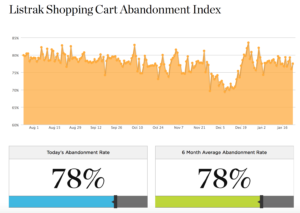
Cart abandonment is a problem that’s getting worse. And eCommerce store owners need to do everything in their power to reduce what is already a problem costing eCommerce trillions of dollars.
Reasons for Cart Abandonment
Before you can tackle the problem of shopping cart abandonment, you’ve got to understand what causes it. There have been dozens of studies into this and, generally speaking, the top causes never really change.
Here’s how a recent study from VWO panned out:
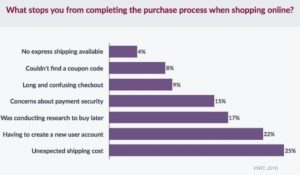
The same worries are echoed across the board as demonstrated by this report from eMarketer:
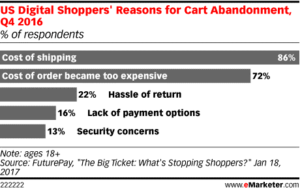
The problem isn’t in knowing what’s causing people to abandon their carts, but in knowing how to stop them from doing so.
To this end we’ve put together 5 top tips that help combat the biggest problems in eCommerce so you can stop worrying about securing more sales and focus on growing your business.
Experiment With Funnel Length
Checkout processes that are overly long, confusing, and downright frustrating.
We’ve all experienced them and we all know that complicating things is a great way for a business to annoy the hell out of customers.
And so most of the advice you read online talks about the reduction of the process. How you should be minimizing the number of steps necessary for a customer to move from browsing to purchased product.
They’ll quote studies like Neil Patel’s simplification of form fields or the single page checkout that converted way higher than a multistage checkout.
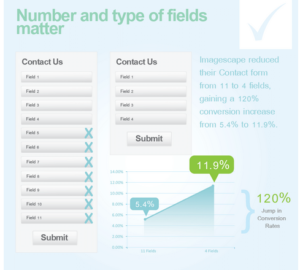
Simplification is apparently all you need.
But that’s BS. If you sell a very complicated product like camera equipment then pushing a product through single page checkout isn’t going to work. Users need to know how a new lens works with their current equipment, whether it’s great for their needs, and if they can afford it.
Instead of simplifying everything, look at the products you sell and ask yourself if your users would be better served if you reduced the funnel or lengthened it to better educate them.
It sounds counterproductive, but it can work. Invesp increased conversions by 38% for an eCommerce store selling products over $2k by implementing a multi-stage checkout.
If you’re worried about it getting too technical then look into products that help streamline a longer checkout process. Guided selling is a great solution because it adds a gamification element to hold interest whilst making it easier for users to find their perfect product.
Free Shipping
This really is a quick and dirty solution.
Unexpected shipping costs are the number one deterrent for completed purchases. So of course it should be one of the first things you address.
Most of the studies into shopping cart abandonment list the problem as unexpected shipping costs. It’s not a case of people not wanting to pay for an item to be shipped, it’s because an extra $10 is added on only at the final stage of the checkout.
So you’ve got two fixes. The first is to simply offer free shipping to all customers. Stitch labs have done a little digging and believe that free shipping can help a business increase its revenue by up to 10%.
Another option is to ensure that the value of a customer’s cart is displayed at all times and that the price includes shipping fees to prevent them from getting a surprise when they hit the final confirmation stage.
Asos does a good job of this as can be seen below:
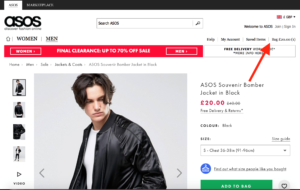
Urgency and Scarcity
We all want what we can’t have.
When presented with a time limit we’re more likely to take immediate action. According to behavioral psychologists the time limit forces us to suspend logical thought processes in favor of immediate action.
For eCommerce that means the customer who’s unsure whether they want to go ahead with the purchase can be persuaded to take immediate action if you make it clear to them that they may miss out.
You can give the impression of urgency through two methods. The first is to add a hard time limit to a sale or offer, the second is to clearly list your stock levels.
Both of which will show your customers that the item won’t be around forever and will give them a little encouraging push to complete their purchase.
Travel companies are pretty awesome at this. Take a look at the below and see how they list availability to force immediate action:
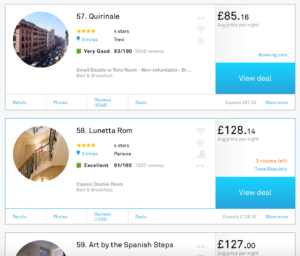
Guest Checkout
If I’m buying a present for my partner/cousin/sister/mother’s birthday it’s going to be a one off.
I don’t want to have to sign up to a mailing list and receive correspondence about products and services I have no interest in. I want the one time purchase to be exactly that. A one time action.
And if you’re aggressively pushing for my email then yes, I will leave.
It goes against much of the advice you’ll have read, but sometimes foregoing the collection of an email address to focus on the immediate sale is exactly what you need to do.
Not all of your customers will want to return numerous times in the future. Give those people the option to checkout as guest and maintain their anonymity.
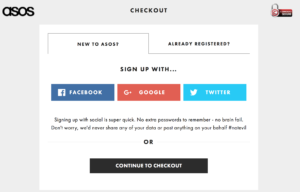
Asos giving users the option to not sign up.
Retargeting and Re-engagement
You’re never going to eradicate cart abandonment.
Your store is always going to attract users who change their mind at the last minute or simply add an item to their cart for them to return to later.
But the simply act of adding an item to a cart shows an incredibly high intent to purchase. One which you need to act upon.
If your efforts to persuade the user to convert right now don’t work you have to run a retargeting or re engagement campaign. This can take one of two-forms.
The first is to place a tracking pixel on product pages and run a retargeting campaign for it. Then, the next time that abandoned user is on Facebook they’ll see promotions for the product they added to their cart.
Everywhere they go for the two week period after abandoning their purchase they’re reminded of the product they liked enough to add to their cart.
The second option is a little more aggressive and involves direct outreach. With a god ESP you could (and should) be sending the user who abandoned cart abandonment emails.
Abandoned checkout emails feature the product they left behind and offer some form of incentive for them to complete the purchase.
Both are effective methods and, according to eMarketer, more and more businesses are focusing on retargeting.
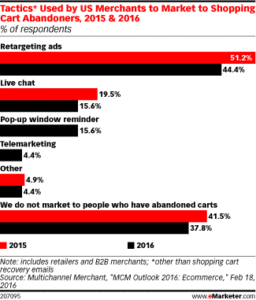
And with results like those listed by Johnathan Dane his article about retargeting make it easy to understand why people are focusing on it:

Your Store’s Future Relies on You Preventing Abandonment
You will always have users who abandon their cart, but you shouldn’t be letting them walk away without a fight.
The steps outlined in this piece should help you regain much of the business you could otherwise have lost, but you should always be looking at your store and how you can improve it to secure more deals you might otherwise have lost.
If you’d like to learn about how Reactful could help you retain more of the business you’re close to losing, CTA

